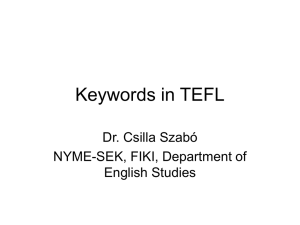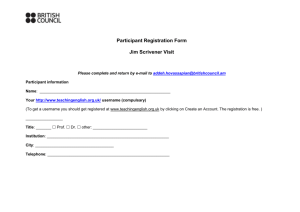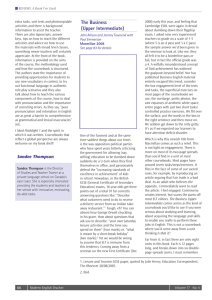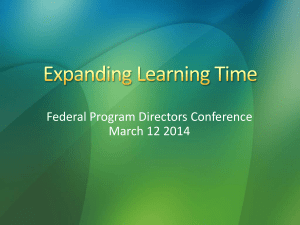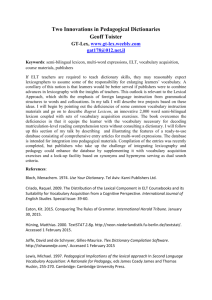Smith, R., Gray, J., Freeman, D., Kiai, A.W., Tanaka, M.... IATEFL 2012 Glasgow
advertisement
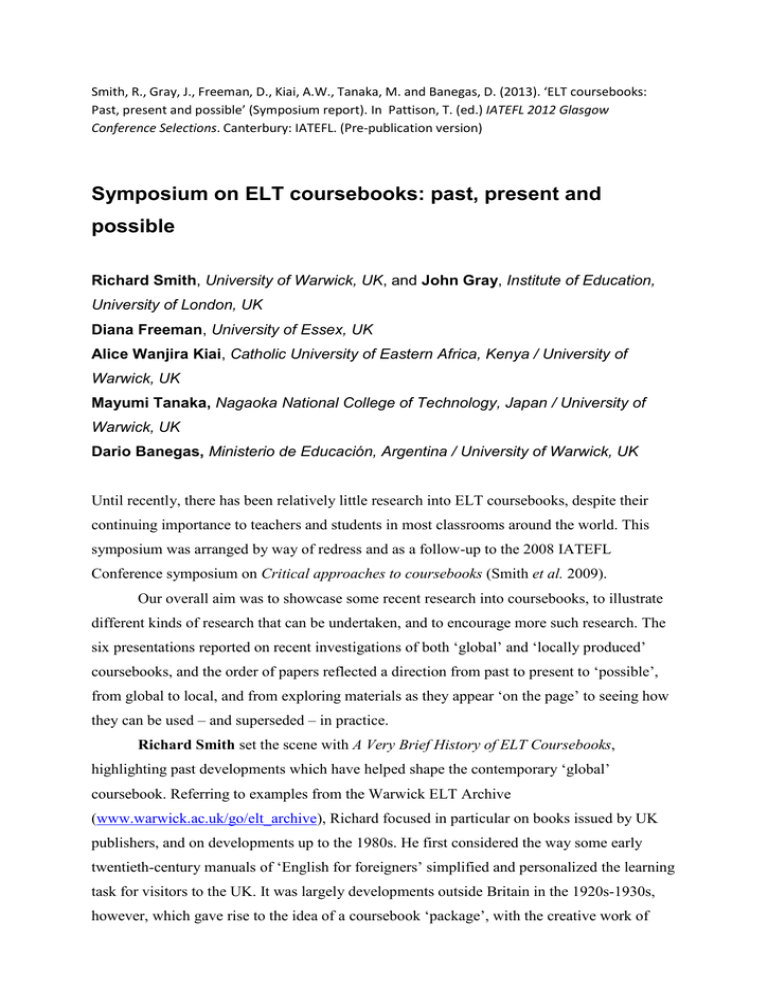
Smith, R., Gray, J., Freeman, D., Kiai, A.W., Tanaka, M. and Banegas, D. (2013). ‘ELT coursebooks: Past, present and possible’ (Symposium report). In Pattison, T. (ed.) IATEFL 2012 Glasgow Conference Selections. Canterbury: IATEFL. (Pre-publication version) Symposium on ELT coursebooks: past, present and possible Richard Smith, University of Warwick, UK, and John Gray, Institute of Education, University of London, UK Diana Freeman, University of Essex, UK Alice Wanjira Kiai, Catholic University of Eastern Africa, Kenya / University of Warwick, UK Mayumi Tanaka, Nagaoka National College of Technology, Japan / University of Warwick, UK Dario Banegas, Ministerio de Educación, Argentina / University of Warwick, UK Until recently, there has been relatively little research into ELT coursebooks, despite their continuing importance to teachers and students in most classrooms around the world. This symposium was arranged by way of redress and as a follow-up to the 2008 IATEFL Conference symposium on Critical approaches to coursebooks (Smith et al. 2009). Our overall aim was to showcase some recent research into coursebooks, to illustrate different kinds of research that can be undertaken, and to encourage more such research. The six presentations reported on recent investigations of both ‘global’ and ‘locally produced’ coursebooks, and the order of papers reflected a direction from past to present to ‘possible’, from global to local, and from exploring materials as they appear ‘on the page’ to seeing how they can be used – and superseded – in practice. Richard Smith set the scene with A Very Brief History of ELT Coursebooks, highlighting past developments which have helped shape the contemporary ‘global’ coursebook. Referring to examples from the Warwick ELT Archive (www.warwick.ac.uk/go/elt_archive), Richard focused in particular on books issued by UK publishers, and on developments up to the 1980s. He first considered the way some early twentieth-century manuals of ‘English for foreigners’ simplified and personalized the learning task for visitors to the UK. It was largely developments outside Britain in the 1920s-1930s, however, which gave rise to the idea of a coursebook ‘package’, with the creative work of Lawrence Faucett (1892-1978) in China, Michael West (1888-1973) in Bengal and Harold Palmer (1877-1949) in Japan being particularly influential. By way of A.S. Hornby (18981978) and L.G. Alexander (1932-2002) in the post-war era, the presentation ended with a brief appreciation of the innovative 1970s-1980s work of Brian Abbs and Ingrid Freebairn, authors of the Strategies series (Rixon and Smith 2012), and with a listing of topics of concern to coursebook publishers, writers and users which would benefit from being researched historically. Diana Freeman, in her paper It’s a Question of Questions, presented her research into the types of questions and tasks that accompany the reading texts in global EFL coursebooks. She has created a taxonomy of eight question-types identifiable in coursebooks, grouping these into three categories: ‘Content’ questions covering lower to higher order comprehension questions, ‘Task’ questions requiring the learner to carry out lexical and form-related language activities and ‘Interaction’ questions which involve the learner responding to the text both on a purely personal level, with no ‘correct’ answers, as well as on a deeper, evaluative level. In addition to demonstrating this taxonomy’s practical application for teachers and materials writers, Diana presented the results of her analysis of these questiontypes in the four editions of Headway Intermediate (Soars and Soars 1986, 1996, 2003 and 2009). As might be expected, ‘Content’ question-types dominate but perhaps less anticipated was that the greatest proportion of these were of the higher order variety. Another interesting finding was the decline of “Task” type questions over the 2nd, 3rd and 4th editions, particularly those focused on form In Neoliberalism, celebrity and ‘aspirational content’ in ELT textbooks for the global market John Gray focused on representations of celebrity in UK textbooks from the late 1970s until the present. John argued that the growth of ‘celebrity culture’ could be seen as congruent with the spread of neoliberal ideology and economic policies which celebrate the values of the market and of extreme individualism over all notions of the collective. John argued that the increasingly frequent use of celebrity in best-selling coursebook series (Streamline, Strategies, Headway and Cutting Edge) produced over the period in which neoliberalism had come to the fore was directly traceable to what ELT publishers describe as ‘aspirational content’. John explained how he adopted a content analysis approach (first counting and categorising the celebrities featured) and then followed this up with a more qualitative analysis. The analysis revealed a focus on increasingly spectacular individual (rather than collective) achievement and a noticeable shift towards the deployment of celebrity characters from the 1990s onwards who were typified by their endorsement of neoliberal values – a view which John argues needs to be challenged. Alice Wanjira Kiai next recounted ‘An English Language Textbook Story from the “House of TESEP”’. She explained how her study sought to meet the need for textbook research that includes not only aspects of production and use, but also perspectives from different stakeholders. With reference to two frameworks, Littlejohn (1998) and Gray (2010), she analysed and discussed documentary evidence from the Kenyan secondary school syllabus and Head Start Secondary English (Bukenya et al. 2003-2005). She generated data from interviews and questionnaires to the curriculum developer, publisher, authors, teachers and learners. The reading section was received most positively by users, with frequent reference being made to ‘Close Shave’, a short, generally humorous piece at the end of each unit. The study also juxtaposed stakeholder responses to similar issues, thus highlighting the gap between ideas and implementation, such as that between the intentions of curriculum developers, publishers and authors with regard to learner-to-learner interaction and the prevalence of a teacher-led environment in practice. The study highlighted the need for greater and sustained collaboration and feedback across different groups involved in textbook production and use. Mayumi Tanaka also considered 'locally produced' coursebooks in her paper Dealing with Constructed Cultural 'Reality' in Japanese High School Coursebooks. Based on the view that the ‘realities’ represented in coursebooks are ‘constructed’, she employed Critical Discourse Analysis in relation to cultural contents of Japan-published coursebooks. On this basis she developed a reading course in which both students and their teacher could challenge the contents of texts and co-construct their own cultural realities in the classroom. Adopting an action research approach, she collected students' interpretations of the texts and feedback from both the students and other English teachers. The results show that although Critical Discourse Analysis helped the teacher analyze texts critically and develop questions to raise students' critical language and cultural awareness, this approach required substantial time and knowledge of text analysis procedures. Also, the students used not only skills for text analysis that the teacher taught but also more general critical thinking skills. Based on these findings, Mayumi is developing a relatively user-friendly 'toolkit' to help teachers and students work critically with texts, as a primary goal of the next phase of her overall action research project. Darío Banegas concluded with Combining marketed coursebooks and teacherdeveloped materials: reasons, possibilities and challenges, a paper on a collaborative action research (CAR) project carried out at a secondary school in Argentina. It involved four teachers and 90 students. In order to meet students’ demands and needs, the teachers explored language-driven CLIL (Content and Language Integrated Learning) through the combination of a marketed general English coursebook with materials they developed themselves. The lessons and materials were negotiated with the students since they voted for topics and suggested sources of input and activities. The CAR-CLIL project spanned one school year and data was collected through group interviews with the teachers, classroom observations, and student interviews and surveys for feedback after each round of lessons. Teachers’ and students’ voices revealed that the combinations of materials produced dynamic and participatory lessons especially because the teacher-developed materials were contextresponsive. While the international coursebook was considered useful for grammar learning, the teacher-developed materials were engaging for skills work provided they were based on authentic sources for listening development and that topics and activities were negotiated with the students. These six papers indicated some of the avenues materials research has taken in recent times. On the one hand, there is BANA-focused research which has adopted a historical perspective on the ways in which coursebooks have evolved as the ELT industry has grown, including work which has explored the evolution of specific task types across several editions of the same course. This historical focus has been complemented by research into the ways in which these evolving artefacts also reproduce dominant ideologies. At the same time, there has been a welcome rise in TESEP-focused research. Here we have seen multi-faceted studies into country-specific courses involving policy makers, publishers and materials writers, and a much-needed move towards addressing materials-in-action in very different school settings. The presentations exemplified the diversity of research perspectives and methodological approaches currently being pursued in materials research – among them, historical research, content analysis, critical discourse analysis, cultural studies and action research. Overall, we hope we have drawn attention to the value and potential unity in diversity of some of the research currently being carried out. We conclude by reiterating the need for further investigations, given the centrality of coursebooks in most classrooms around the world. Email: r.c.smith@warwick.ac.uk j.gray@ioe.ac.uk dfree@essex.ac.uk awkiai@yahoo.com tmayumi0516@hotmail.com dariobanegas@hotmail.com References Bukenya, A., D. Njeng'ere, A. Kioko, V. Mutei and J. Njue. 2003-2005. Head Start Secondary English. Nairobi: Oxford University Press - East Africa. Gray, J. 2010. The Construction of English: Culture, Consumerism and Promotion in the ELT Global Coursebook. Basingstoke: Palgrave Macmillan. Littlejohn, A.P. 1998. ‘The analysis of language teaching materials: inside the Trojan horse’. In Tomlinson, B. (ed.) Materials Development in Language Teaching. Cambridge: Cambridge University Press. Rixon, S. and R. Smith. 2012. ‘The work of Brian Abbs and Ingrid Freebairn’ (Survey Review). ELT Journal. Smith, R., Kullman, J., Gray, J., Wharton, S., Santos, D. and Pennycook, A. 2009. 'Critical approaches to coursebooks'. In Beaven, B. (ed.) IATEFL 2008 Exeter Conference Selections. Canterbury: IATEFL. Soars, L. and Soars, J. 1986 (1st ed.), 1996 (2nd ed.), 2003 (3rd ed.) and 2009 (4th ed.). Headway Intermediate. Oxford: Oxford University Press
